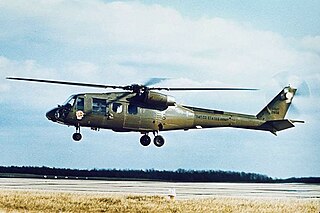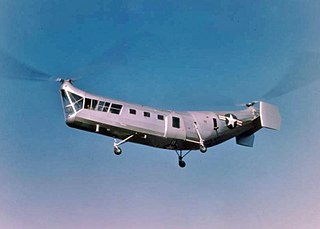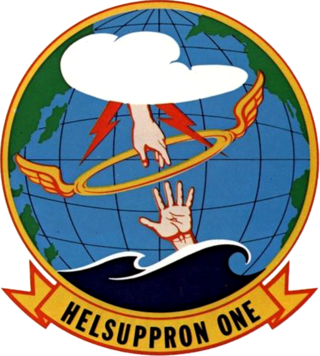
The Kaman SH-2 Seasprite is a ship-based helicopter originally developed and produced by American manufacturer Kaman Aircraft Corporation. It has been typically used as a compact and fast-moving rotorcraft for utility and anti-submarine warfare (ASW) missions. Early on it was modest sized single-engined naval utility helicopter, and progressed to twin-engine ASW and SAR, and the latest model served well into the 21st century, with G model in active service in the 2020s with Egypt, New Zealand, Peru, and Poland.

The Sikorsky H-19 Chickasaw is a multi-purpose piston-engined helicopter that was used by the United States Army and United States Air Force. It was also license-built by Westland Aircraft as the Westland Whirlwind in the United Kingdom. United States Navy and United States Coast Guard models were designated HO4S, while those of the U.S. Marine Corps were designated HRS. In 1962, the U.S. Navy, U.S. Coast Guard and U.S. Marine Corps versions were all redesignated as H-19s like their U.S. Army and U.S. Air Force counterparts.

The Sikorsky CH-124 Sea King is a twin-engined anti-submarine warfare (ASW) helicopter designed for shipboard use by Canadian naval forces, based on the US Navy's SH-3 Sea King. Most CH-124s were assembled in Quebec by United Aircraft of Canada. The CH-124 served with the Royal Canadian Navy (RCN) and Canadian Armed Forces from 1963 to 2018.
Piasecki Helicopter Corporation designed and manufactured helicopters in Philadelphia and nearby Morton, Pennsylvania, in the late 1940s and the 1950s. Its founder, Frank Piasecki, was ousted in 1956 and started a new company, Piasecki Aircraft. Piasecki Helicopter was renamed Vertol Corporation in early 1956. Vertol was acquired by Boeing in 1960 and renamed Boeing Vertol.

The Piasecki X-49 "SpeedHawk" is an American four-bladed, twin-engined experimental high-speed compound helicopter developed by Piasecki Aircraft. The X-49A is based on the airframe of a Sikorsky YSH-60F Seahawk, but utilizes Piasecki's proprietary vectored thrust ducted propeller (VTDP) design and includes the addition of lifting wings. The concept of the experimental program was to apply the VTDP technology to a production military helicopter to determine any benefit gained through increases in performance or useful load.

The Piasecki H-21 Workhorse/Shawnee is an American helicopter, the fourth of a line of tandem rotor helicopters designed and built by Piasecki Helicopter. Commonly called "the flying banana", it was a multi-mission helicopter, capable of being fitted with wheels, skis or floats.

A tandem-rotor aircraft is an aircraft with two large helicopter rotor assemblies mounted one in front of the other in the horizontal plane.

The Sikorsky H-34 is an American piston-engined military utility helicopter originally designed by Sikorsky as an anti-submarine warfare (ASW) aircraft for the United States Navy. A development of the smaller Sikorsky H-19 Chickasaw (S-55), the H-34 was originally powered by a radial engine, but was later adapted to turbine power by the British licensee as the Westland Wessex and by Sikorsky as the S-58T. The H-34 was also produced under license in France by Sud Aviation.

The Sikorsky H-5 is a helicopter built by Sikorsky Aircraft Corporation.

The Boeing Vertol YUH-61 was a twin turbine-engined, medium-lift, military assault/utility helicopter. The YUH-61 was the runner-up in the United States Army Utility Tactical Transport Aircraft System (UTTAS) competition in the early 1970s to replace the Bell UH-1 Iroquois helicopter. At the end of the flyoff program, Sikorsky Aircraft was awarded a contract to develop and build its UH-60A entry.

Helicopter Training Squadron EIGHT (HT-8) is a United States Navy helicopter training squadron based at Naval Air Station Whiting Field in Milton, FL. The squadron's mission is helicopter pilot training for U. S. Navy, U. S. Marine Corps and U. S. Coast Guard Student Naval Aviators and for selected foreign military flight students from basic helicopter flight training through winging. Student Naval Aviators report to HT-8 for helicopter training upon completion of primary flight training conducted in the T-6B Texan II U. S. Navy primary flight trainer. HT-8 flies the TH-73A Thrasher, an

The United States Army Aviation Museum is an aviation museum located on Fort Novosel near Daleville, Alabama. It has the largest collection of helicopters held by a museum in the world. The museum features some 50 aircraft on public display with aviation artifacts ranging from a replica of the Wright brothers' Model B military biplane to an RAH-66 Comanche. The museum has over 160 aircraft in its collection and holds 3,000 historical items.

The American Helicopter Museum & Education Center (AHMEC) is located at 1220 American Boulevard, West Chester, Pennsylvania, United States. The transport museum focuses on the history, science and technology of rotary wing aviation. The collection contains over 40 civilian and military, autogyros, convertiplanes and helicopters, including some early generation models. The museum also has an extensive research library, the Renzo Pierpaoli Memorial Library, which contains documents, artifacts, films, and memoirs that museum members can use.

The Piasecki HRP Rescuer is a United States tandem-rotor transport or rescue helicopter designed by Frank Piasecki and built by Piasecki Helicopter. The Piasecki PV-3 was adopted as the HRP-1 Rescuer by the United States Navy, United States Marine Corps, and United States Coast Guard. An improved PV-17 variant was later produced as the HRP-2. As one of the first transport helicopters in military service, the HRP-1 was capable of carrying two crewmen and 8–10 passengers or 2,000 lb. (907 kg) of cargo.

The Sikorsky XHJS-1, was developed by Sikorsky Aircraft to meet a Naval requirement for a utility helicopter. The XHJS-1 was not ordered into production and only two prototypes were built.

The Shearwater Aviation Museum is an aviation museum located at CFB Shearwater in Shearwater, Nova Scotia. The museum acquires, conserves, organizes, researches and interprets to Canadian Forces personnel and the public at large for their study, education and enjoyment, artifacts and documents which exemplify the history of Canadian maritime military aviation.

Helicopter Combat Support Squadron 1 (HC-1) was a helicopter squadron of the United States Navy operating several helicopter types in support of United States Pacific Fleet ships and other units. The squadron was established on 1 April 1948 and disestablished on 29 April 1994. It was nicknamed "Pacific Fleet Angels" or just "Angels".





























